Urban tiny forests: A good thing
Can ultra small urban forests—tiny forests—be as good for biodiversity as larger plots? We’re talking the size of a tennis court that’s literally jammed with plants to achieve the highest possible biodiversity. It’s the brainchild of Shubhendu Sharma, an Indian automotive engineer, that’s being tested by the Dutch Institute for Nature Education and Sustainability (IVN).
IVN planted the first tiny forest just north of Amsterdam in Zaanstad in 2015. Known as the Groene Woud (Green Woods), the space has 40 species of 600 trees. A second tiny forest, the Gouwse Forest, was planted slightly differently—they also added fruiting shrubs to the planting plan. More tiny forests followed.
Last year (2017), the Dutch Ministry of Agriculture funded research to take a look at their effect on biodiversity through the year. What they found is that that, yes, they do make a difference in biodiversity when compared to nearby forests in terms of the numbers of species and individuals. But the researchers say that’s likely due to the fact that the tiny forests are located near parks, so they attracted species already present.
The real question is how tiny forests would perform in more urban spaces. And would they impact air quality, recharge aquifers and cool cities, too, in addition to boosting biodiversity by providing additional usable habitat?
The Netherlands’ Nationale Postcode Loterij is providing 1.8 million Euros ($2.1 million) to fund the tiny forests project to extend the concept nationally.
If you're interested in learning more, Shubhendu Sharma founded Afforest to promote tiny forests worldwide.
—Excerpted from Urban tiny forests are good for biodiversity from Wageningen University and Research, Wageningen, the Netherlands
____________________________________________________________________

U.S. Green Building Council guide to green infrastructure

Green roofs are one of the ideas presented in the U.S. Green Building Council's new resource, Green Infrastructure Menu of State Policy Options.
If you’re working to help your state incorporate more green infrastructure into law, the U.S. Green Building Council (USGBC) has developed a new resource, the Green Infrastructure Menu of State Policy Options, that may be helpful, especially if you seek to incorporate the use of a rating system into the legislated framework. USGBC and Green Business Certification, Inc. (GBCI) can help cities and states incorporate their rating systems into tangible green infrastructure development with rating tools like LEED, SITES and Parksmart.
The USGBC Guide recaps a history of legislation both introduced and passed at the state level to implement a number of green infrastructure policies. It includes a range of options for state lawmakers. The menu is organized into seven areas: cool roofs; green roofs; solar roofs; permeable pavement; reflective/cool pavement; urban trees/urban forestry; and studying/financing green infrastructure.
Many of the bills listed in the menu are comprehensive, with language impacting areas beyond the category to which they've been assigned. This guide is intended to be a living document to be updated as more state legislatures take action to expand the uptake of green infrastructure practices.
____________________________________________________________________

Sterile lantana from University of Florida
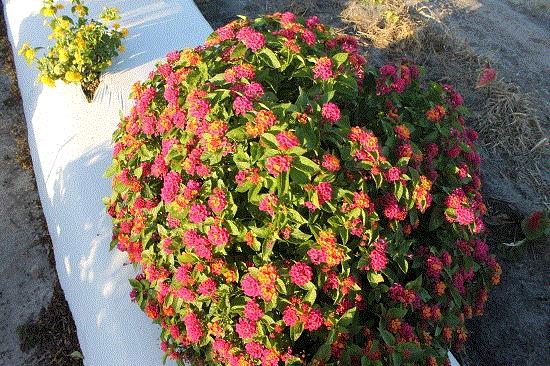
Bloomify Rose is one of the new sterile lantana cultivars released by the University of Florida. Photo: Zhanao Deng, UF/IFAS
Sterile, non-invasive lantana was the goal of University of Florida plant scientist Zhanao Deng’s breeding program started in 2004. It’s resulted in Bloomify Rose and Bloomify Red, both lantana cultivars that don’t fruit and seed, so they're incapable of crossing with Florida’s native Lantana depressa.
The most widely cultivated lantana, Lantana camara, is native to the West Indies. It was introduced to the United Stated in the 1800s. In Florida, lantana is invasive.
“Genetic sterilization of invasive or potentially invasive landscape plants and development of non-invasive cultivars are a necessity,” said Zhanao, a faculty member at the UF/IFAS Gulf Coast Research and Education Center in Balm, Florida.
Like other types of lantana, these two new varieties attract butterflies and are drought- and salt-tolerant.
—Excerpted from New Lantana Plants Protect Native Flora and Enhance Landscapes by Brad Buck, University of Florida
____________________________________________________________________

“A New Garden Ethic”
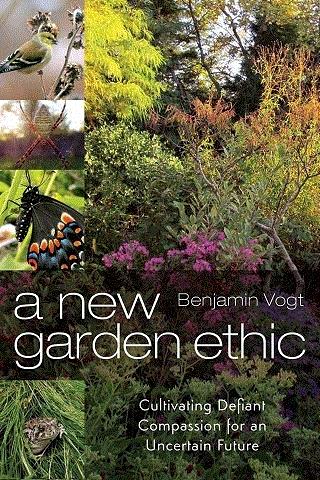
Benjamin Vogt, author of “A New Garden Ethic: Cultivating Defiant Compassion for an Uncertain Future,” reached out to ask if I would share this book review and North State Public Radio podcast on Cultivating Place with NewTerrain readers. So I checked it out.
It’s a great podcast in which Benjamin talks about applying concepts and principles in “A Land Ethic” to gardens. A garden writer and landscape designer, Benjamin gardens and writes in Nebraska. His garden and nature framework was formed through childhood experiences in his mother’s garden, the woods of suburban Minnesota and the Oklahoma prairie.
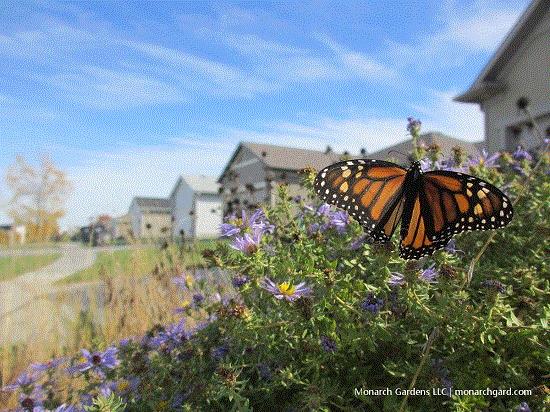
Cultivating Place’s host Jennifer Jewell shares about Benjamin’s book, “He goes on to share his mission of believing that ‘our gardens matter and the way in which we create them, grow them and rethink them matter on the highest of levels.’ Finally, that ‘our legacy won’t be how pretty our gardens looked; our legacy will be how our gardens and other managed spaces woke us to a revolution of belonging in this world, a renaissance of ethical thinking that helped us evolve into our fullest potential as stewards of life and gardeners of our own hearts.’”
Benjamin also has a garden design company, Monarch Gardens LLC. He may be reached at monarchgard@gmail.com.
__________________________________________________________________________

Getting children to “see” plants: Addressing "plant blindness"
The average American can recognize 1,000 brand names and logos, but fewer than 10 local plants, resulting in "plant blindness." Seed Your Future’s new BLOOM! campaign connects young people to the power of plants.
Plants are critical to the future of the planet, but absent from the minds of most American youth.
BLOOM! will help excite kids about the power of plants.

BLOOM! is the movement to improve the world through the power of plants by inspiring today's youth to find their own plant power and unlock the potential of the natural world around them.
"This campaign is all about opening young people's eyes to the incredible power of plants to change the world,” said Anna Ball, president and CEO of Ball Horticultural Company and co-chair of the Seed Your Future National Leadership Cabinet. "Whether BLOOM! introduces today's youth to a lifelong passion or a fulfilling career, one thing is clear—the more we know about plants, the more we can make a difference in the world today."
Horticulturists tackle some of the world's biggest challenges, such as feeding a growing population, curing disease, climate change and clean water. They're also making playing fields safer for athletes, creating fabric for clothing, growing plants that soothe and heal us, and making the world a happier, more beautiful place.
BLOOM! is the first major initiative of Seed Your Future, a coalition of more than 150 partners that are united in their mission to promote horticulture and the diverse careers the industry offers.
_________________________________________________________________________

Using virtual reality to test green

Could the future bring major development and urban projects with no pushback or criticism from the public because they “experienced it” in advance? What if the public could virtually experience the site beforehand? And what if planners, engineers, architects and designers could incorporate that feedback before breaking ground?
NC State University researchers digitally manipulated vegetation in a downtown Raleigh plaza using virtual reality to study how people react when they're surrounded by nature. What they found was that people want more green when they’re surrounded by concrete.
NC State University experts used immersive virtual reality (IVR) to test perceptions of green enclosures. Researchers with the Center for Geospatial Analytics used a robot to capture 360-degree, high-resolution images of a downtown Raleigh plaza and a city park, then manipulated the vegetation to create different environments.
Then they digitally manipulated the vegetation to provide different virtual experiences. Virtual visitors to the downtown plaza near tall buildings wanted to be surrounded by green vegetation, said graduate student Payam Tabrizianas, College of Design and lead author.
The top-rated landscape design among 90 immersive virtual reality testers was one with trees on all four sides in a medium-density arrangement.
“In an urban setting, being enclosed by vegetation feels restorative. It can serve as a shield from the urban environment and create a kind of refuge where people can sit and relax for a while,” said Payam. “People preferred urban environments that were very green and being enclosed in vegetation didn’t seem to bother them that much.”
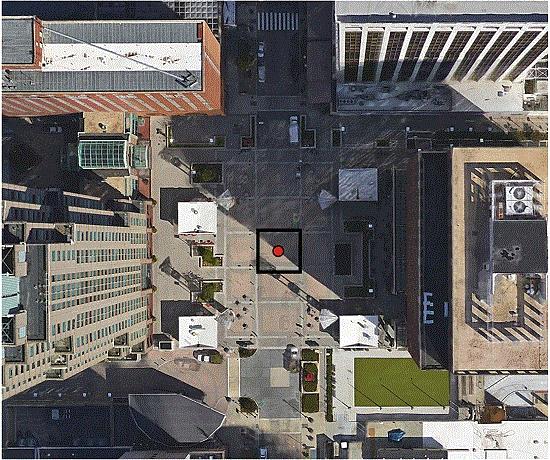
When surrounded by concrete, like this downtown Raleigh plaza, people wanted more green.
But virtual visitors to Raleigh’s Fletcher Park weren't as comfortable with green density. There, virtual visitors to the park wanted to know what’s happening around them. “When you enclose them with vegetation, they don’t like it. They feel unsafe,” Payam said.
“This technology allows us to design a true experiment in which we control the variables, without ever planting or moving a tree.”
—Excerpted from Using Virtual Reality to Plot Urban Green Spaces by D'Lyn Ford NC State University
Exploring perceived restoration potential of urban green enclosure through immersive virtual environments by Payam Tabrizian, Perver K. Baranappears, William R. Smith and Ross K. Meentemeyer in the Journal of Environmental Psychology.
__________________________________________________________________________________________
NYC Forests need $385 million over 25 years
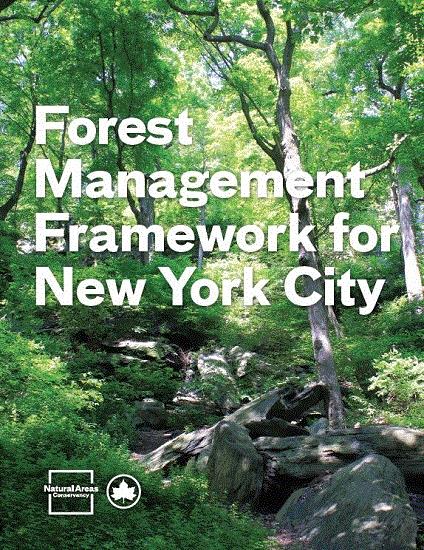
The "Forest Management Framework for New York City" by the Natural Areas Conservancy and the NY City Parks Department outlines the current state and needs of the city’s valuable urban forest. The report is a first-of-its-kind document gathering in one location a comprehensive assessment and broad-stroke recommendations, and is the result of six years of research, data collection and analysis. The report identifies 519 acres of urban forest that are under high thread from invasive plants, including understory trees, vines and herbaceous groundcover. Another 2,527 acres are under medium threat.
“Forest Management Framework for New York City” makes the case for the City of New York to invest $385 million over the next 25 years to maximize the urban forest resource for city residents’ recreational uses while maintaining forest health.
_____________________________________________________________________
Guess what? Trees move water at night, too
A team of Danish and Hungarian researchers performed high-precision, three-dimensional surveys of 21 different species of trees and learned that they experience subtle canopy movement during the night. These tree "sleep cycles" differed from one species to another.
Some trees also lower their branches by as much as 4 in. at night and then back up in the morning. The slow movement is hard to see. However, the team used laser scanning, a 3-D surveying technique to measure the exact position of branches and leaves.
The movement has to be connected to variations in water pressure within the plants and this effectively means that the tree is pumping.
“Water transport is not just a steady-state flow, as we previously assumed," said postdoc András Zlinszky, Aarhus University.
All the trees showed some kind of branch or leaf movement of a few centimeters during the experiment. However, the overnight 12-hour cycle of lowering and returning to the starting position was only observed in seven of the species studied. The results revealed that some trees have "sleep periods" shorter or longer than 12 hours and others show slow continuous movement in one direction, probably because of disease or senescence.
Magnolia grandiflora completed three full cycles of up-and-down branch or leaf movement over one night. Although the crown displacement measured was less than 0.5 in.
Short interval overnight laser scanning suggest sub-circadian periodicity of tree turgor by András Zlinszky et. al. in Plant Signaling & Behavior.
_____________________________________________________________________
Comparing black locust and linden for cooling effects
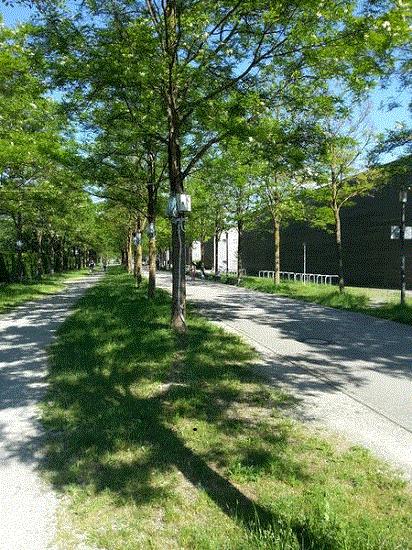
One of the test sites with black locust (Robinia pseudoacacia) planted in downtown Munich on the Lehrer-Wirth-Strasse. Measuring instruments were attached below the foliage. (Picture: F. Rahman/ TUM)
Trees cool their environment and cities benefit from it, but the degree of cooling depends on the tree species and the local conditions. In a recent study, scientists at the Technical University of Munich (TUM) compared how well black locust and linden trees do the job. It’s an important question in Munich, where temperatures in the city are as much as 10F higher than the surrounding countryside.
The TUM team pit small-leafed linden (Tilia cordata) against black locust (Robinia pseudoacacia).
“Tree species, such as the black locust, that consume little water can provide a higher cooling effect if they are planted on grass lawns,” Dr. Mohammad Rahman, TUM explained. “The surrounding soil remains moister thanks to the trees, the grass dissipates additional heat through the evaporation of water and thus reduces the temperature near the ground.”
However, the linden has a superior cooling capacity that's fed by a dense treetop that provides shade, and leaf surfaces reflect the short-wave rays of the sun and also use them to power transpiration.
These cooling mechanisms are common in all plants, including grass. But the linden has a larger and denser canopy, along with higher water loss from leaf stomata. Linden trees use a large percentage of the intercepted radiation to vaporize water, hence, cooling the surrounding micro-climate better.
The black locust has a less dense crown and smaller leaf surface area, so transpiration is lower. That makes the linden tree more effective when it comes to cooling on mild summer days. However, the black locust needs less water than the linden. Therefore, when trees are planted in grassy lawns, there’s an additional cooling function from the grass surfaces under black locust trees that seems more effective.
The researchers speculate that with climate change and accelerating drought, either we have to water grassy lawns for a greater cooling effect under tree species, such as linden, or develop more drought-tolerant tree species. But for paved surfaces, better cooling from the dense shade of linden trees is more effective.
—Excerpted from a TUM press release
Vertical air temperature gradients under the shade of two contrasting urban tree species during different types of summer days by Mohammad A. Rahman, Astrid Moser, Anna Gold, Thomas Rötzer and Stephan Pauleit in Science of the Total Environment.
__________________________________________________________________________________________________
TurfMutt environmental cartoon character honored
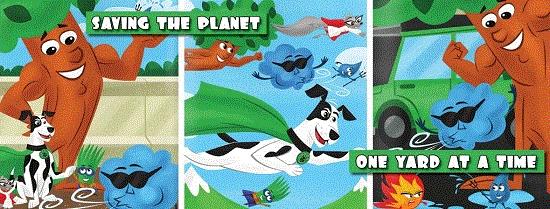
Turffmutt's Facebook banner.
TurfMutt, the Outdoor Power Equipment Institute’s (OPEI) environmental education and stewardship program, received an honorable mention in PRNews’ CSR & NonProfit Awards program.
“The message of this program is powerful. We all have a responsibility to take care of our living landscapes. These green spaces influence our lives in important ways,” said Suzanne Henry, president of Four Leaf Public Relations LLC, creators of TurfMutt.
Lucky, the real-life rescue dog of Kris Kiser, President and CEO of OPEI, is the “spokesdog” behind the TurfMutt program. The campaign’s message is that nature starts at your backdoor and living landscapes—such as our yards, parks and other community green spaces—and are critical to our health and well-being.
TurfMutt has reached more than 68 million children, educators and families since 2009, showing them how they can “save the planet, one yard at a time.”
_________________________________________________________________________
EPA Campus RainWorks winners
The University of Illinois at Urbana—Champaign and University of California—Berkeley lead in innovative design of green infrastructure on campus in the EPA’s 6th annual 2017 RainWorks competition.
The Campus RainWorks Challenge asks students and faculty members at colleges and universities across the country to apply green infrastructure design principles, foster interdisciplinary collaboration and increase the use of green infrastructure on the nation’s college campuses. Student teams compete in two design categories: the Master Plan category, which examines how green infrastructure can be broadly integrated across campus; and the Demonstration Project category, which focuses on how green infrastructure can address stormwater pollution at a specific site on campus.
University of Illinois at Urbana—Champaign (1st Place Demonstration Project Category) won with “Campus Hydro Redesigned” that integrates a variety of green infrastructure practices into a campus parking lot, reducing impervious area and completely mitigating the stormwater runoff from remaining impervious surfaces.
University of California—Berkeley (1st Place Master Plan Category) won with "(Re) Generations,” a project that exemplifies long-term commitment and vision in stormwater management. Using Strawberry Creek as a connective thread, the team’s design strategically phases green infrastructure across the campus, capturing 100% of the university’s stormwater runoff by 2100.
University of New Mexico (2nd Place Demonstration Project Category). “Johnson Field (Re)Creation.”
University of Maryland—College Park (2nd Place Master Plan Category). “Champion Gateway.”
First-place teams will receive a $2,000 student prize to be split among team members and a $3,000 faculty prize to support green infrastructure research and education. Second-place teams will receive a $1,000 student prize and a $2,000 faculty prize.
EPA plans to announce the seventh annual Campus RainWorks Challenge in the summer of 2018. Since 2012, nearly 600 teams have participated in the Challenge.
_____________________________________________________________________
Reader comment
“Just a quick shout out to let you know how much I value and appreciate your e-newsletter. You’re keeping an eye out and reporting promptly and accurately! I’m very busy, but always take the time to review your news. Thanks for the continued good work.”
—Lloyd Singleton
Worth reading
We calculated how much money trees save for your city by Theodore Endreny for The Conversation.
Homes or gardens? In poor inner-city neighborhoods, a scramble for vacant land pits developers against urban farmers by Lea Ceasrine for FERN, Food & Environment Reporting Network.
Climate Change Gives Invasive Trees an Even Greater Advantage by Jeff McMahon for Forbes.
Using the right plants can reduce indoor pollution and save energy from Cell Press on Phys.org.
Germany moving ahead with plans to restrict weed-killer glyphosate from Reuters.
Making It Rain: Effective Stormwater Fees Can Create Jobs, Build Infrastructure and Drive Investment in Local Communities by Alisa Valderrama and Becky Hammer for Natural Resources Defense Council.
Vancouver adopts bylaw to cut watering to two days during summer months from Canadian Press on The National Post.
San Francisco to plant 2,000 trees in carbon-neutral effort by Danielle Haynes for UPI.
Urban Development is Making Dallas Hotter. This Study Says More Trees Are the Answer by Justin Martin on KERA News.
Philly has a plan to replace decaying water pipes and sewers. And you will pay for it by Andrew Maykuth on Philly.com.
Drought Returns to Huge Swaths of U.S., Raising Fears of Shortages by David Montgomery on Governing.
Statewide 10-million tree-restoration effort launches on Mount Joy-area farm by on Lancaster Online.com.
I'm skeptical of the synthetic age, says ecology philosopher Christopher Preston by JP O’Malley on The Ecologist.
GOP maneuver could roll back decades of regulation by Zachary Warmbrodt on Politico.
Georgia’s Traveling Trees—An oligarch's whim is leaving Georgia’s lush Black Sea coast scarred with patches of deforestation by Giorgi Lomsadzeon Eurasianet.
Residents band together to protect strip of trees by Terrence McDonald on NJ.com.
City staff and developers broadly interpret tree protection ordinance to allow old growth trees to be removed against wishes of local residents—City tree ordinance doesn't protect trees as well as citizens thought by Jeffrey Schweers in the Tallahassee Democrat.
Mount Vernon Government Center Goes Native by Mary Paden for Connection Newspapers.
Landscape architect Cornelia Hahn Oberlander on why it should be easier to be green by Hadani Ditmars on Wallpaper.
Maintaining and Increasing Carbon in the Managed Landscape an Ecological Landscape Alliance (ELA) Conference Session Summary by Alexis Doshas on ELA website.
U.S. rivers are becoming saltier—and it’s not just from treating roads in winter by Sujay Kaushal, Gene E. Likens, Michael Pace and Ryan Utz on The Conversation.
AIPH—Health and Sustainability addressed at AIPH Green City Conference in FloraCulture International.
Montreal's green alleys have environmental, community benefits, experts say by Canadian Press for BarrieToday.com.
The Battery, NYC’s downtown park, sets ‘standard for urban parks’ by Nicole Brown on am New York.
The Birds, the Bees, and the Lawsuit by Janice Kasperson for Forester Network.
Report: Trees in Baton Rouge provide millions of dollars of value in drainage, other benefits by Steve Hardy for The Advocate.
Charleston to take new look at its signature treescape by Bo Petersen in the Post and Courier.
Homes near green spaces fetch higher prices: study by Romesh Navaratnarajah on PropertyGuru.com.sg.
4 ways urban green spaces can benefit the environment on AccuWeather.com.
Green roofs improve our lives. Why don't we have more of them? by Jenna Hammerich for the Iowa City Press-Citizen.
Study: Aiken's trees worth more than $130M by Colin Demarest in the Aiken Standard.
Can Green Infrastructure Save America's Capital from Overflowing Sewage? Ambitious plan aims to keep waste out of rivers without massive new pipes by Gabriel Popkin for Inside Science.
Why you should grow a lawn for bees—Leave these weed flowers intact, and pollinators will thank you. by Tom Oder on Mother Nature Network.
More trees could help soak up stormwater by David Quick in the Charleston Post and Courier.
Mayor Fischer’s 2018-2019 budget targets investments in green infrastructure, public safety, jobs, Louisville’s future in The Lane Report, Kentucky’s Business News Source.
In a Divisive Political Environment, Maintaining the Focus on Climate Change by Jared Green on ASLA’s The Dirt.
Savannah launches Green Infrastructure to Green Jobs Initiative by Emily Woodward for the University of Georgia Marine Extension and Georgia SeaGrant.
Invasive tick finds foothold in New Jersey by Lindsey Konkelon FERN’s Ag Insider.
New Horizons for Market-Based Stormwater Management by Abby Martin for the Conservation Finance Network.
How Road Salt and Stormwater Affects Tree Health by Michael James on Deep Root.
For urban problems, “trees are the answer” by AnnaLisa Michalski in The Virginian-Pilot.
Best,

Debbie Hamrick
NewTerrain
This email was received by 18,802 readers.
If you're interested in advertising in NewTerrain, contact Kim Brown.